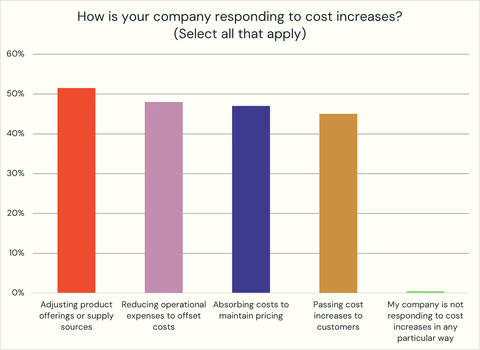
44% of US Businesses Plan to Pass Tariff Costs to Customers, Zilliant reports
Zilliant, the leader in pricing lifecycle management, released findings from its Business Tariff Impact Survey, revealing how U.S. business leaders are adapting pricing strategies amid evolving trade conditions, in particular confirming that many are planning to pass on costs and shift suppliers in response to the rapid changes in U.S. tariff strategy.
The survey of 400 senior executives—including CEOs, chief financial officers, and chief revenue officers from companies with over $250 million in revenue—provides insight into how businesses are responding to recent tariff policy shifts and other macroeconomic challenges.
“Businesses continue to face difficult decisions about how to manage changing cost structures, but the past five years of disruptions and inflation have helped prepare them for this moment,” said Pascal Yammine, CEO of Zilliant. “While this data outlines the strategic approaches companies are taking to maintain profitability in this volatile environment, it will be crucial for them to be transparent with customers, partners, shareholders and other stakeholders about their decision-making and avoid potential backlash.”
The survey found that 90% of business leaders report that macroeconomic factors have impacted their pricing levels over the past 12 months, with 44% describing the impact as “significant” or “severe.”
Tariffs Are Shifting Business Plans
Tariffs are increasingly influencing business strategy, with 23% of respondents identifying tariff-related expenses as their primary pricing challenge in 2025—second only to competitive pricing pressures (33%). In response to these changes, companies are implementing multiple strategies:
- 44% of businesses plan to pass increased costs to customers as a direct result of recent tariff changes.
- 45% of respondents identified tariff-related expenses—including the tariffs themselves and rising supplier costs—as their primary pricing challenges in 2025.
- 42% of companies have shifted suppliers or sourcing regions to respond to tariff changes, indicating a significant reshaping of supply chains.
Competition Also a Top Concern for the Future
While tariffs are top-of-mind, the majority (33%) of respondents cited competitive pricing pressures as their primary pricing challenge in 2025. Looking ahead 12-24 months, both “competitive price wars” and “tariff and trade uncertainty” are tied as the biggest concerns at 27% each.
“What we’re seeing is a significant shift in how companies approach pricing strategy as respondents understand how tariffs will be a blanket concern for their industry and will be monitoring how competitors react,” said Stephan Liozu, chief value officer at Zilliant. “Rather than making across-the-board price increases, forward-thinking organizations are implementing targeted pricing strategies that balance profitability with competitive positioning.”
Despite these challenges, 87% of executives remain optimistic about maintaining profitability amid current economic conditions. One potential source of this widespread optimism is the availability of AI solutions—83% of respondents say they are currently using AI-driven pricing technology to adapt to economic volatility.
CEOs/Chief Commercial Officers Are Leading Pricing Decisions
The survey also revealed in light of the importance of pricing in today’s times, CEO’s & CCO’s are taking the driving seat when it comes to pricing decision-making. This also suggests that those who do not elevate those decisions to the top risk falling behind.
- 98% say they have an internal champion who is the final decision-maker on how to update their pricing strategy in light of market conditions, although that role varies.
- 87% of chief commercial officer respondents said they’re the decision-maker.
- 68% of CEOs claimed that responsibility.
- As far as who they think should be the final decision-maker, the majority (56%) think it should be the CEO.
The survey included respondents from diverse industries, including manufacturing, finance, IT/telecommunications, retail, building, education, and others, providing a comprehensive view of how tariff impacts vary across sectors. Zilliant will release the full report next week, offering deeper analysis of industry-specific trends and strategic recommendations for businesses navigating the complexities of tariff-influenced pricing. Tariff impact on pricing strategy










